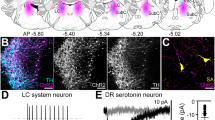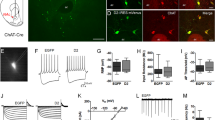Abstract
IN the peripheral nervous system, acetylcholine (ACh) acts on presynaptic muscarinic receptors to inhibit the release of noradrenaline (NA) from nerve terminals and by way of nicotinic presynaptic receptors to stimulate release1. A NA–ACh interaction has also been postulated2–7 to occur in the central nervous system (CNS). Cholinergic agonists decrease the levels of NA in various brain areas5,6, affect the release of NA in in vitro preparations3,4 and have similar effects in vivo as measured by increased metabolites of NA (ref. 2). A reciprocal interaction, that of NA modulating ACh release in the CNS does not seem to occur, according to evidence8 available at present. We report here that depletion of forebrain NA by intracerebral injection of the selective neurotoxin 6-hydroxydopamine (6-OHDA) almost completely blocks the catalepsy induced by cholinergic agonists such as pilocarpine and arecoline9–12 and enhances the locomotor stimulation caused by the anticholinergic drugs scopolamine and atropine13–15. Although these actions have most usually been ascribed to an interaction with dopamine (DA) systems16,17, our data show that functionally significant interactions between ACh and NA systems also occur.
This is a preview of subscription content, access via your institution
Access options
Subscribe to this journal
Receive 51 print issues and online access
$199.00 per year
only $3.90 per issue
Buy this article
- Purchase on Springer Link
- Instant access to full article PDF
Prices may be subject to local taxes which are calculated during checkout
Similar content being viewed by others
References
Westfall, T. C. Physiol. Rev. 57, 659–728 (1977).
Davis, K. L., Hollister, L. E., Goodwin, F. K. & Gordon, E. K. Life Sci. 21, 933–936 (1977).
Westfall, T. C. Life Sci. 14, 1441–1452 (1974).
Westfall, T. C. Neuropharmacology 13, 693–700 (1974).
Glisson, S. N., Karczmar, A. & Barnes, L. Neuropharmocolgy, 11, 465–477 (1972).
Glisson, S. N., Karczmar, A. & Barnes, L. Neuropharmacology 13, 623–632 (1974).
Reader, T. A., De Champlain, J. & Jasper, H. Brain Res. 111, 95–107 (1976).
Barnes, L., Cann, F., Karczmar, A. G., Kindel, G. & Longo, V. G. Pharmac. Biochem. Behav. 1, 35–40 (1973).
Zetler, G. Int. J. Neuropharmac. 7, 325–335 (1968).
Timsit, J. Therapie 21, 1453–1455 (1966).
Baez, L. A., Eskridge, N. K. & Schein, R. Eur. J. Pharmac. 36, 155–161 (1976).
Costall, G. & Olley, J. Neuropharmacology 10, 297–301 (1971).
Pradham, S. N. & Roth, T. Psycopharmacology 12, 358–361 (1968).
Campbell, B. A., Lytle, L. & Fibiger, H. C. Science 166, 637–638 (1969).
Fibiger, H. C., Lytle, L. & Campbell, B. A. J. comp. Physiol. Psychol. 72, 384–391 (1970).
Roberts, D. C. S., Zis, A. P. & Fibiger, H. C. Brain Res. 93, 441–450 (1975).
Creese, I. & Iversen, S. D. Brain Res. 83, 419–436 (1975).
Uretsky, N. J. & Iversen, L. L. Nature 221, 557–559 (1969).
Ungerstedt, U. Acta physiol. scand. suppl. 367, 1–49 (1971).
Lindvall, O. & Bjorklund, A., Acta Physiol. scand. suppl. 412, 1–48 (1974).
McGeer, E. G. & McGeer, P. L. Can. J. Biochem. 40, 1141–1151 (1962).
Siegel, S. Nonparametric Statistics (McGraw-Hill, New York, 1956).
Winer, B. J. Statistical Principles in Experimental Design (1962).
Lidbrink, P. Brain Res. 74, 19–40 (1974).
Lidbrink, P. & Fuxe, K. J. Pharm. Pharmac. 25, 84–87 (1973).
Bird, S. J. & Kuhar, M. J. Brain Res. 122, 523–533 (1977).
Papp, M. & Bozsik, G. J. Neurochem. 13, 697–703 (1966).
Pavlin, R. J. Neurochem. 12, 515–518 (1966).
Scheibel, M. E. & Scheibel, A. B. Brain Inf. Serv. Conf., Rep. No. 32 Brain Information Service, Brain Research Institute, Los Angeles, 1973.
Amatruda, T. T., Black, D. A., McKenna, T. M., McCarley, R. W. & Hobson, J. A. Brain Res. 98, 501–515 (1975).
Mitler, M. M. & Dement, W. C. Brain Res. 68, 335–346 (1974).
van Dongen, P. A. M., Broekkamp, C. L. E. & Cools, A. R. Pharm. Biochem. Behav. (in the press).
Author information
Authors and Affiliations
Rights and permissions
About this article
Cite this article
MASON, S., FIBIGER, H. Possible behavioural function for noradrenaline–acetylcholine interaction in brain. Nature 277, 396–397 (1979). https://doi.org/10.1038/277396a0
Received:
Accepted:
Issue Date:
DOI: https://doi.org/10.1038/277396a0
This article is cited by
-
α2-Adrenoceptor antagonists potentiate acetylcholinesterase inhibitor effects on passive avoidance learning in the rat
Psychopharmacology (1996)
-
Evidence for an in vivo and in vitro modulation of endogenous cortical GABA release by α-glycerylphosphorylcholine
Neurochemical Research (1996)
-
Brain muscarinic cholinergic receptor binding in Roman high- and low-avoidance rats
Psychopharmacology (1981)
Comments
By submitting a comment you agree to abide by our Terms and Community Guidelines. If you find something abusive or that does not comply with our terms or guidelines please flag it as inappropriate.



